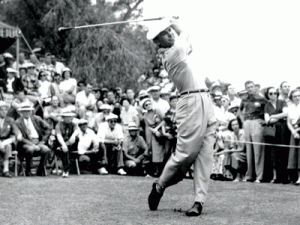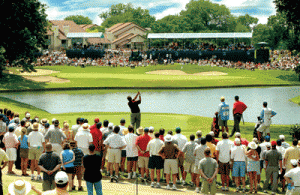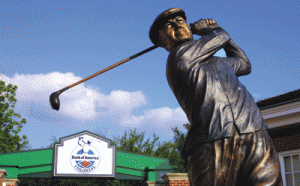The course was founded in 1936 by Marvin Leonard, a partner in the locally famous Leonard Brothers Department Store who sought to bring championship golf to Fort Worth. Leonard also sponsored Hogan, who was at that time a struggling young local golfer trying to scratch out a living on the pro circuit.
Hogan grew up near Fort Worth in Stephenville and caddied as a youngster at the same Fort Worth club as Byron Nelson. When they squared off one year for the club’s caddie championship, Nelson won.
 Colonial’s 60th anniversary could have occurred four years earlier had World War II not intervened. After the course successfully hosted the 1941 U.S. Open, PGA Tour officials wanted to start an annual event there. Talks stalled with the onset of the war, and five years later the Colonial tournament resumed in May 1946. Hogan took the title that year and the next, then again in 1952, 1953 and 1959.
Colonial’s 60th anniversary could have occurred four years earlier had World War II not intervened. After the course successfully hosted the 1941 U.S. Open, PGA Tour officials wanted to start an annual event there. Talks stalled with the onset of the war, and five years later the Colonial tournament resumed in May 1946. Hogan took the title that year and the next, then again in 1952, 1953 and 1959.
The course’s traditions have stood the test of time and even spread throughout the PGA Tour, said Dick McHargue, chairman of Colonial’s historical committee and one of the course’s longest-standing volunteers.
Colonial has plenty of sentimental traditions, from the red Scottish tartan plaid jackets that give a nod to the game’s beginnings to the oversized statue of Ben Hogan frozen in the top of his follow-through overlooking the 18th green. There are some practical traditions that the Tour has adopted. Colonial was the first tournament to use a leader board; the first to erect ropes to separate the gallery from the players; the first to set up a hospitality program to look after the players and their family members and the first to incorporate standard bearers to show where each player stands in the tournament. McHargue called Colonial a hospitable environment for the players and “a real easy golf course to watch golf on.”
“Today,” he added, “a lot of courses are stadium courses, where you go sit down some place and wait for the players to come by. Colonial isn’t like that. Sure, we have some stadium seating, but we encourage people to get out and walk around. That’s how we’re set up and part of who we are.”
Anyone who loves the game of golf loves Colonial, McHargue said.
“The players out there have to be really good shot makers and have to be able to work the ball right to left, left to right and straight ahead,” he said. “When the wind blows and the rough is tall, it’s really tough. But anybody who plays well at Colonial can play anywhere in the country.”
 The course is immaculate year-round, but special sprucing sessions for last year’s festivities did not go unnoticed. Crenshaw, who made the cut in his 33rd, and reportedly final, time to play the tournament, commented on how wonderful the course looked this year. He also recalled how special the course has been to him.
The course is immaculate year-round, but special sprucing sessions for last year’s festivities did not go unnoticed. Crenshaw, who made the cut in his 33rd, and reportedly final, time to play the tournament, commented on how wonderful the course looked this year. He also recalled how special the course has been to him.
“This has always been one of my favorites, a perennial favorite,” he said. “It is the most beautiful traditional golf course you’d ever want to see. Just a wonderful place to golf.”
Crenshaw said he treasures his memories of chatting several times with Hogan as he watched the legend practice, but there is one memory of the course he doesn’t relish.
In 1979, angry that he had three-putted the par 3 16th hole, he kicked an oil barrel being used as a garbage can during the third round. That moment of unleashed emotion led to an arthritic big right toe and alignment problems through his hip.
“It was a self-inflicted injury right here,” Crenshaw said. “I’ve thought about it a million times. I sure would like to have that one back.”
 Tim Herron, who won this year’s tournament in his 11th appearance at Colonial, elaborated on Crenshaw’s assessment of the course’s history.
Tim Herron, who won this year’s tournament in his 11th appearance at Colonial, elaborated on Crenshaw’s assessment of the course’s history.
“I love it, being in the middle of all of that whole Hogan and Crenshaw mystique,” Herron said. “It really gets you fired up. You know when you come here you’re in for a special time.”
Herron’s visit to the course actually turned out much better than he had anticipated. The 36-year-old took the title and pocketed $1,080,000 – more than his combined earnings from his three previous tour wins, the last of which was at the 1999 Bay Hill Invitational in Orlando, Fla.
Minutes before donning the champions’ jacket, Herron commented on how tough it is to win a PGA tournament, but added that the effort is worthwhile.
Part of the allure of “Hogan’s Alley” is its reputation as the playground of one of the game’s greatest. From 1946 to 1953, Hogan won nine of the 16 majors he played. He remains third on the all-time list with 63 career wins.
After nearly dying in a 1949 car accident, Hogan came back to win the 1950 U.S. Open. Until Tiger Woods did it in 2000, Hogan was the only man to win three professional majors in one season. In 1953, he captured the Masters, U.S. Open and British Open titles but was unable to play the PGA because it started too close to the finish of the British Open. After 1953, he never won another major.
Hogan’s final victory was on his favorite course in 1959. Until his death in July 1997, Hogan sought perfection in the tools of his beloved game.
Robert Towery, whose wife Jacque is Ben Hogan’s niece, said this was the best he had ever seen the course.
“They really went all out and made things special for the fans and for the players,” he said. “Of course, the players all love to come here and play. I know when Ben was alive, he looked forward to it every time he got to come. It’s just a place like no other. I hope it lives forever.”
By Kelly Levey